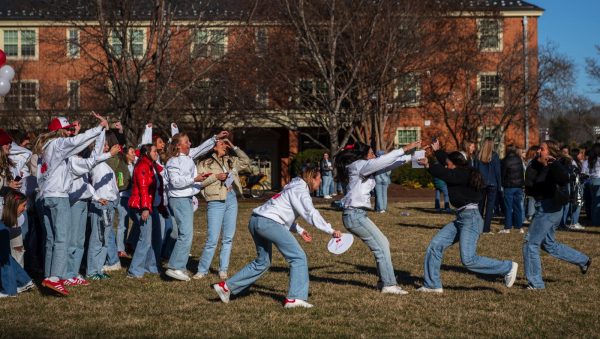Male gaze persists within the institutions of Greek Life
Wake Forest Fraternities perpetuate sexism and degradation of women
April 8, 2021
It seems obvious to suggest that the beings we are – our character, personalities, interests – are the culmination of a variety of influences. These influences often come from different directions or outlets – our parents, peers, communities, media communication. These influences often direct us to act in certain ways or hold particular beliefs.
While these influences may be generally positive, they may also be the product of a broader influence that seems to operate more like a mandate than as an influence. That is, the fragmented influences we encounter — whether it be magazine advertisements promoting increased femininity, the sexualization of women in cinema, the enhancement of sexual female body parts in male-targeted video games and media — all fall under the greater influence of the male gaze. This is the lens through which we see the world.
The male gaze is a theory developed by Laura Mulvey in her piece “Visual Pleasure and Narrative Cinema.” Mulvey demonstrates through cinema how women are depicted as objects for male desire. She argues that the gaze stems from a “scopophilic instinct”; the idea that there is “pleasure in looking at another person as an erotic object.” This instinct is manifested through cinema since cinema not only “highlight[s] a woman’s to-be-looked-at-ness” but because it also “builds the way she is to be looked at into the spectacle itself.” That is, cinema’s hyper-sexualization and objectification of women on screen crafts not only images of desire for men, but it also shapes the way that women are viewed and depicted (women become a part of the grander spectacle; the gaze).
While Mulvey articulates the gaze through its implementation in cinema, this theory has broader implications. In fact, a theory concomitant with the gaze is Judith Butler’s own theory presented in “Imitation and Gender Subordination” that gender is performative. Gender, Butler says, is performative in that it is the product of repetitious performances that are stereotypically attributed to a particular gender identity or sexual orientation. That is, for example, when one dresses up in ways that are typically seen as “feminine” (wearing makeup, a dress, high-heeled shoes), they are performing femininity. And when that performance continues on a regular basis it then becomes a repetition. Furthermore, that repetition not only operates on a small-scale level, but is also a result of the broader repetition and reinforcement of stereotypes. While it follows from Butler that these gender performances are within a repetitious, self-reinforcing cycle that operates outside of ourselves (we are subject to the cycle), we can see this societal mechanism operating in our own lives.
In fact, if we turn to college Greek life on our very own campus, we can quite clearly observe the male gaze and Butler’s theory in action. Fraternities serve as ambassadors to the male gaze; they foster and propagate it at every turn. Let us look no further than the practices of Wake’s fraternities. Each year, a particular fraternity (we’ll just call Fraternity X) hosts a week-long charity event. It is a strategy to raise money for their philanthropy efforts. These events have included tug-of-war competitions amongst girls from different sororities, but most notably, a dance competition called “Air Bands” which consists of each sorority on campus choreographing a dance to be performed to and judged by the men of Fraternity X. This competition often happens in a bar downtown or in the fraternity basement. While the “goal” of the competition may technically be to raise funds for charity (cancer research, etc.) it seems the only material purpose of Air Bands is for women to literally perform their sexuality so they can then be rated by a group of men. The activity literally makes “winners” and “losers” out of a competition that really just aims to identify “who is the sexiest? Who fulfills the most desire?”
Not only are the women literally performing and dancing in a style that directly aims to please men (they are openly encouraged to choreograph promiscuous dance numbers) but they are performing femininity in such a way that will please the men. They are fulfilling ideations of femininity and sexuality in order to fit in accordance with the social norm. The male gaze is not just projected onto women, but women fulfill the gaze when taking part in these activities. Forget rose-colored glasses, we have been forced to look through phallic-shaped glasses.























Holden-tudix • Feb 24, 2022 at 11:59 am
Imagine writing this and not realizing you just lost a cancer charity tens of thousands of dollars. This article is selfish and doesn’t point out that sororities actually vote unanimously in chapter to participate in this event. The girls who participate are actually having a good time because they want to have fun. Life is short, don’t be so bland and obnoxious, Gaby, live life to the fullest. Lastly, Thanks for taking money from children’s cancer research, hARdO.
Arnold Picollo • Apr 13, 2021 at 11:54 am
Do you think the children’s cancer hospitals who have directly received 100’s of thousands of dollars towards groundbreaking research from Fraternity X are concerned about the male gaze while providing their patients receiving treatment? Criticizing charity, how low can the OGB go.